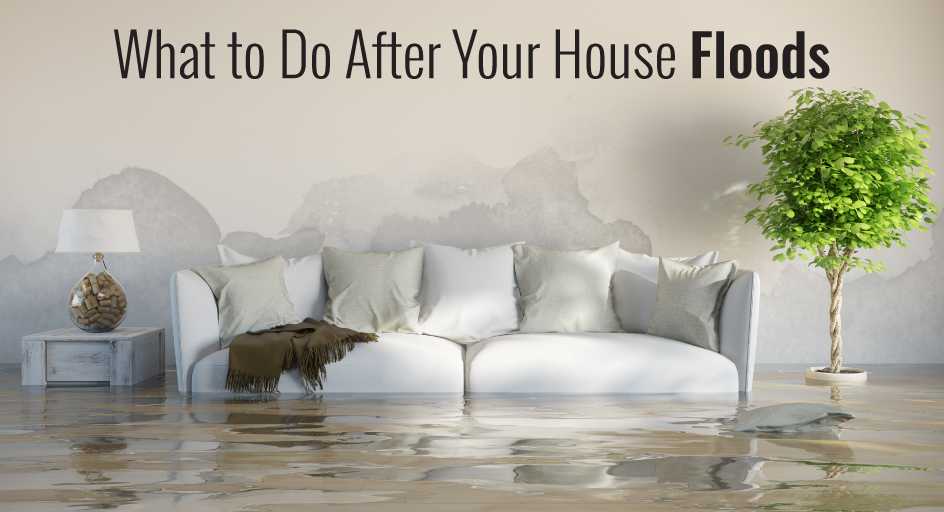
There are a number of ways that your house can flood, whether it’s due to heavy rains, sewer backup, or a pipe burst. While a house flood can be devastating, here are some tips on how to respond if it were to happen to you.
Put Safety First
The first step in any major home disaster is to remain safe. You may be forced to leave your home if the flooding is bad enough. Make sure you are also safe when you return to your home to begin dealing with the aftermath. This may include turning off the power, as water and electricity obviously do not mix. Be sure to wear protective clothing such as rubber boots and gloves when you re enter your home. Not only will you be dealing with the water itself, but also whatever else the water has been in contact with, namely debris or even sewage. It is best to protect yourself against whatever harmful chemicals and items the flooding may have washed in.
Also, never eat food that has been contaminated by flood waters, or even been in close proximity to the water for an extended period of time. If the water was high enough to reach your refrigerator or any of your pantry cabinets, it is best to go ahead and throw the food away and just buy more. In addition, you should thoroughly wash any dinnerware, glasses, or flatware that might have been caught in the house flood before you use it again.
Stop and Remove the Water
One of the first things you should do when your house floods is stop the source of water coming in if at all possible. If your sump-pump is broken or malfunctioning, replacing it will help keep up with any continuing rains and may prevent further damage to your basement, garage, crawl space, or main floor. Calling the city to remove debris from storm drains may also be necessary in order to help stop flooding.
If your flooded home was caused by a bursted pipe, fix the plumbing as soon as possible to lessen water damage. The sooner you stop the water from coming in, the sooner you can get to cleaning up and repairing any damages.
Once no more water is coming in, you can work to remove the water from your home. Depending on the level of flooding you have experienced or even the rooms in your home that have been affected, your process might change. You may need to bail water out using buckets and bins or use hoses to drain large amounts of water from your basement. As the water begins receding, you can use a wet vacuum to suck remaining bits of water and moisture from carpets and floors. If you’re lucky and the damage is minimal, you might be able to simply mop the mess up.
Dry Out Your Home
Even if you are successful in removing all of the standing water from your home, everything will remain damp and wet, especially if heavy rains have increased the humidity in your area. If you have power, use your air conditioning and portable fans to help dry the wet areas of your home.
Dehumidifiers are also a big help, especially in closed off spaces such as basements or crawl spaces. Dehumidifiers work by removing excess moisture from the air. This is the easiest way to dry out your home and minimize the potential water damage you might be dealing with, as it does not require you to actively clean. However, in the case of a house flood, dehumidifiers are only supplemental and you are likely to need multiple methods of action. Dehumidifiers are recommended for anyone who lives in a damp climate or an area that experiences longer rainy seasons, as they can prevent some of the problems associated with this type of weather, both for you and your home.
Call Your Insurance Agent
Your homeowners insurance will vary depending on what policies you have, but many insurance companies cover flooding due to storms, backed-up city sewers and storm drains, broken sump-pumps, or bursted pipes. Your insurance company will send an adjuster to look at and assess the damage to determine if it is a covered loss. If your losses and damages are covered, the sooner you call your agent, the sooner they will pay out. Repairs can become costly, but the insurance money will help get your home back in order quicker with less of a financial burden on you.
Clean Up
Once the water is gone and you have called your insurance company, it’s time to begin post-flood care. You can call in a professional clean-up crew or do the work yourself. This may involve determining what is salvageable and throwing away anything that is too damaged or no longer safe to use. If the flooding in your home was widespread, you may have to bring in a roll-off dumpster for easy disposal of larger damaged items, as you will find your trash bags filling quickly.
Be aware that you may need to remove flooring, drywall, and insulation to prevent mold and mildew from spreading in your home. Furniture may also need to be dried out, cleaned, or thrown away depending on the level of water damage. Unless you are exceptionally handy, it is probably best to call in a professional company that specializes in mold removal. Mold can begin developing within the first 24 hours after a flood, and once it has started growing, it can be difficult to fully remove. The quicker you remove items from water and begin drying them, the less likely they are to be lost to mold, but it’s always best to err on the side of caution and have a professional assess the situation.
If you’ve experienced flooding for any reason or want to be covered against possible floods in your area, call your agent today for assistance.